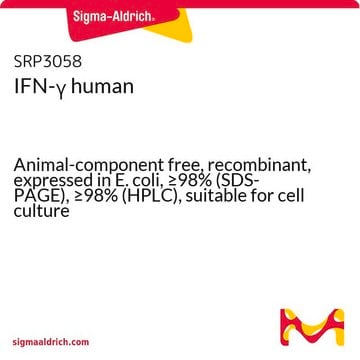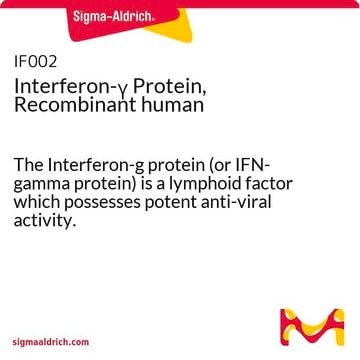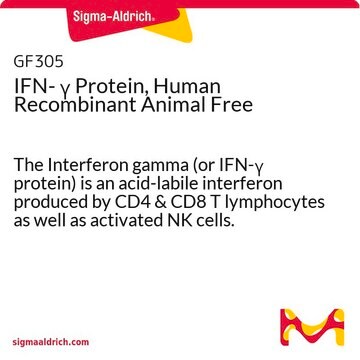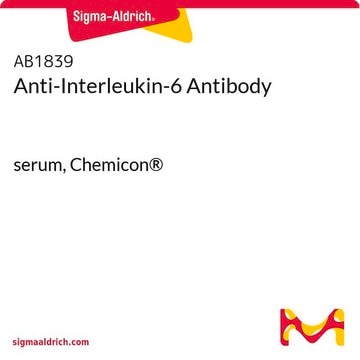GF314
TNF- α Protein, Human Recombinant Animal Free
Tumor necrosis factor alpha (TNF-α), also known as cachectin & TNFSF1A, is the prototypic ligand of the TNF superfamily. Recombinant animal free human TNF-α is manufactured using all non-animal reagents.
Sinônimo(s):
Tumor Necrosis Factor Alpha, TNFa, TNF-alpha, Cachectin, TNFSF1A
Faça loginpara ver os preços organizacionais e de contrato
About This Item
Código UNSPSC:
12352202
eCl@ss:
32160405
NACRES:
NA.77
Produtos recomendados
recombinante
expressed in E. coli
Nível de qualidade
Ensaio
>98% (SDS-PAGE and HPLC)
Impurezas
<0.1 μg/mg protein endotoxin (<1EU/μg)
nº de adesão NCBI
nº de adesão UniProt
Condições de expedição
dry ice
Categorias relacionadas
Descrição geral
Product Source: E. coli
Tumor necrosis factor alpha (TNF-α), also known as cachectin and TNFSF1A, is the prototypic ligand of the TNF superfamily. It is a pleiotropic molecule that plays a central role in inflammation, apoptosis, and immune system development. TNF-α is produced by a wide variety of immune and epithelial cell types. It belongs to the TNF family of ligands and signals through two receptors, TNFR1 and TNFR2. TNF-α is cytotoxic to a wide variety of tumor cells and is an essential factor in mediating the immune response against bacterial infections. TNF-α also plays a role in the induction of septic shock, auto immune diseases, rheumatoid arthritis, inflammation, and diabetes. Recombinant human TNF-α is a soluble 157 amino acid protein (17.4 kDa) which corresponds to C-terminal extracellular domain of the full length transmembrane protein.
Especificidade
Cross Reactivty
Cow, Monkey, Mouse, Rat, Sheep
Cow, Monkey, Mouse, Rat, Sheep
Aplicação
Research Category
Inflammation & Immunology
Inflammation & Immunology
Research Sub Category
Growth Factors & Receptors
Growth Factors & Receptors
Qualidade
Bioactivity assay: The ED50 as determined by the cytolysis of murine L929 cells in the presence of Actinomyocin D is ≤ 0.05 ng/ml, corresponding to a specific activity of ≥2 x 107 units/mg.
forma física
Product is filtered through a 0.2 micron filter before lyophilization.
Recombinant animal free human TNF- α is manufactured using all non-animal reagents
Armazenamento e estabilidade
Store at -20°C for up to 6 months from date of receipt.
Exoneração de responsabilidade
Unless otherwise stated in our catalog or other company documentation accompanying the product(s), our products are intended for research use only and are not to be used for any other purpose, which includes but is not limited to, unauthorized commercial uses, in vitro diagnostic uses, ex vivo or in vivo therapeutic uses or any type of consumption or application to humans or animals.
Código de classe de armazenamento
11 - Combustible Solids
Classe de risco de água (WGK)
WGK 3
Certificados de análise (COA)
Busque Certificados de análise (COA) digitando o Número do Lote do produto. Os números de lote e remessa podem ser encontrados no rótulo de um produto após a palavra “Lot” ou “Batch”.
Já possui este produto?
Encontre a documentação dos produtos que você adquiriu recentemente na biblioteca de documentos.
Os clientes também visualizaram
Bjarne Østerud et al.
Journal of thrombosis and haemostasis : JTH, 20(4), 866-876 (2021-11-26)
Most tissue factor (TF) activity assays are based on measurement of factor X (FX) activation by TF in the presence of factor VII (FVII)/FVIIa. This requires long incubation, which may result in TF-independent activity of FX and inaccurate measurement of
Toll-like receptor 9 (TLR9) gene deletion-mediated fracture healing in type II diabetic osteoporosis associates with inhibition of the nuclear factor-kappa B (NF-I?B) signaling pathway.
Han, et al.
Bioengineered, 13, 13689-13702 (2022)
Ruo-Yu Chen et al.
Cell death & disease, 12(11), 983-983 (2021-10-24)
Chronic and persistent inflammation is a well-known carcinogenesis promoter. Hepatocellular carcinoma (HCC) is one of the most common inflammation-associated cancers; most HCCs arise in the setting of chronic inflammation and hepatic injury. Both NF-κB and STAT3 are important regulators of
Ruo-Yu Chen et al.
Cell death and differentiation, 27(4), 1259-1273 (2019-09-13)
Centrosomal P4.1-associated protein (CPAP) is overexpressed in hepatocellular carcinoma (HCC) and positively correlated with recurrence and vascular invasion. Here, we found that CPAP plays an important role in HCC malignancies. Functional characterization indicated that CPAP overexpression increases tumor growth, angiogenesis
Roxane Verdikt et al.
EBioMedicine, 79, 103985-103985 (2022-04-17)
The multiplicity, heterogeneity, and dynamic nature of human immunodeficiency virus type-1 (HIV-1) latency mechanisms are reflected in the current lack of functional cure for HIV-1. Accordingly, all classes of latency-reversing agents (LRAs) have been reported to present variable ex vivo
Nossa equipe de cientistas tem experiência em todas as áreas de pesquisa, incluindo Life Sciences, ciência de materiais, síntese química, cromatografia, química analítica e muitas outras.
Entre em contato com a assistência técnica







